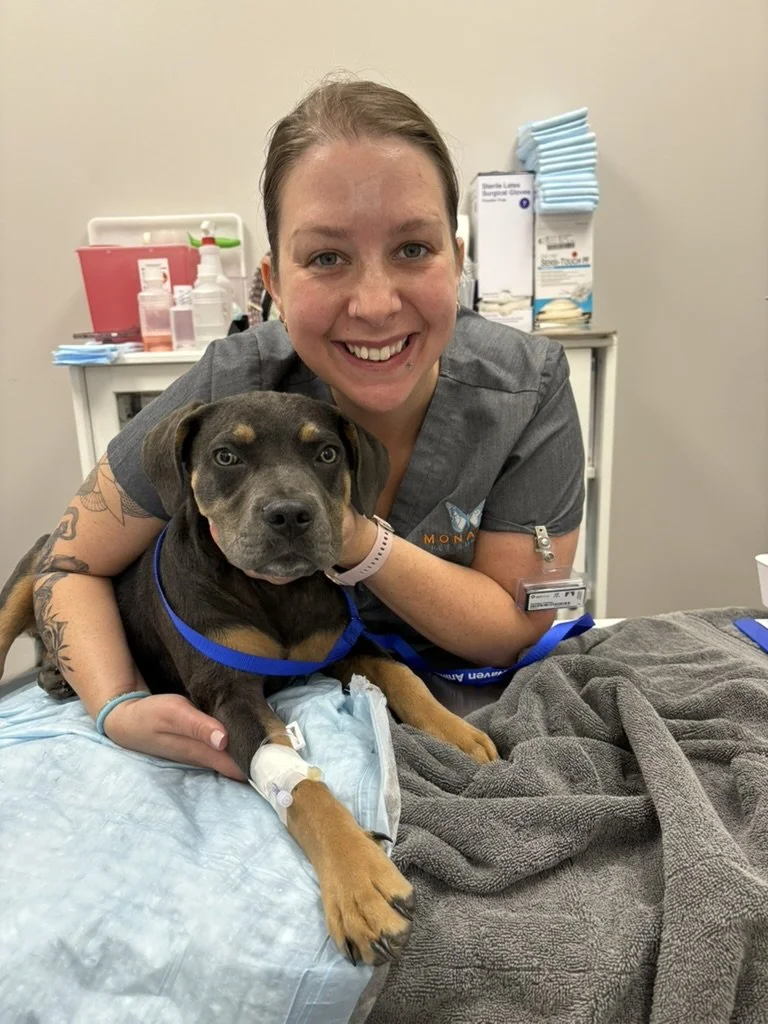Care in Every Step
As pet owners ourselves, we understand how stressful it can be to navigate your pet’s surgery. That’s why we’ve outlined each step of our surgical process — from referral to recovery — so you know exactly what to expect. Our goal is to provide clear communication, compassionate care, and a smooth experience for both you and your pet every step of the way.
Before Surgery
Chelsey is getting Napa ready to take some radiographs!
-
After your pet is scheduled for surgery through your primary care veterinarian, our team will reach out and get you scheduled for a phone consultation.
This is a great time to have a list of current medications your pet is taking ready!
On the day of your consultation, Dr. Bascuñán will review your pet's history, the surgical plan, recovery expectations, and answer any questions you may have. We will send a surgical consent to sign electronically after your consultation is complete.
-
Your pet will need diagnostics, such as pre-surgical bloodwork, radiographs, or ultrasound, based on of the type of surgery they need. We will work with your primary veterinarian to ensure these results are received before surgery.
-
Prepare a quiet, comfortable space that is free of furniture where your pet can rest and recover safely. This could be a large crate, a small enclosed room (like a bathroom or laundry room), or a secure area set up with an exercise pen. If your home has slippery floors, consider placing yoga mats or rugs to provide better traction and prevent accidental slips.
-
Try to keep your pet’s daily routine as normal as possible to help minimize stress. Your pet will not be able to eat any food past midnight (unless otherwise directed by Dr. Bascuñán). Water is okay in moderation the morning of dropping your pet off for surgery.
Day of Surgery
Dr. Bascuñán is performing a TPLO on a patient with the help of her assistant, Maggie. Look at that sterile surgical site!
-
The morning of surgery, you will drop your pet off at your primary veterinarian. The time for drop off is provided by your primary vet clinic.
Upon Monarch’s arrival, we will get vitals (weight, heart rate, temperature, respiration rate just to name a few) and Dr. Bascuñán will perform a physical exam on your pet.
Your pet will also have an IV catheter placed so they are able to receive medications, IV pain control and IV fluids throughout surgery.
-
Once your pet is under anesthesia, they will be monitored by one of our technicians, who will stay with your pet the entire time they are anesthetized and recovering after surgery.
Another Monarch technician will begin prepping the surgical site by clipping the fur, scrubbing the area with an antiseptic solution, and finally using an iodine solution. This allows Dr. Bascuñán and the assistant to remain sterile after scrubbing in!
-
We will be reaching out over text message and/or phone call to inform you of what stage of the surgical process we are in!
Once surgery is complete, Dr. Bascuñán will call you to inform you how the surgery went and answer any questions you have.
We ask that you have your phone with you at all times until your pet is in recovery.
-
Once surgery is completed, your pet will recover with their designated technician.
Post surgical vital signs are obtained and IV pain control is continued until your pet is discharged to go home.
Once your pet is awake from anesthesia, the care of your pet will be transferred to the trusted team at your primary vet clinic.
Recovery & At Home Care
Comfort and care go hand in hand — Stella is recovering great!
-
Once your pet has been discharged, they will head home to continue the recovery process.
You will receive detailed discharge instructions that includes everything from incision care to recheck schedule.
We recommend having a safe and comfortable space in your vehicle to travel home. You'll need to assist your pet getting in and out of the vehicle to help prevent any accidental injury as they recover.
Once you and your pet are home safe, they will need to go a quiet, comfortable space where they can rest and recover safely. This could be a large crate, a small enclosed room, or a secure area set up with an exercise pen. If your home has slippery floors, consider placing yoga mats or rugs to provide better traction and prevent accidental slips.
-
After surgery, your pet may be a little sleepy or wobbly as the anesthesia wears off. It’s completely normal for them to want to curl up and rest. Some pets may whimper or seem a bit confused — this is almost always a side effect of anesthesia drugs and not a reflection of their pain
We strongly encourage you to maintain their pain control medication schedule even when they are not acting painful!
-
As they start to feel more like themselves again, it is VITAL your pet continues restricted activity and wears an e-collar.
We do not want your pet to be able to reach their surgical site and compromise it in any way. Until you receive further instruction from your primary veterinarian, your pet MUST wear the e-collar at all times.
They will need to avoid running, jumping, playing of any kind, and no off leash activity will be permitted. Keep them confined in order to limit movement and protect the surgical site. Oral medications may be used to help keep your pet calm and relaxed as they heal.
-
Monarch Pet Surgery is always here for you and your pet. If you have any non urgent questions about your pet, please feel free to contact us via text, phone call, or email!
If you have an urgent or emergent concern about your pet’s recovery, please contact your primary care veterinarian or the nearest emergency veterinary clinic right away.




